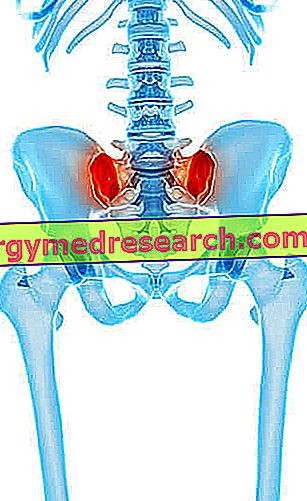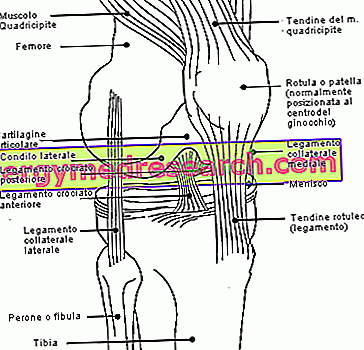Generality
Sacroiliitis is inflammation of the sacral iliac joints (or sacroiliac joints).

The causes of sacroiliitis include: injuries of traumatic origin, arthritis, the state of pregnancy, different types of infections, etc.
The typical symptom of sacroileitis is back pain, a pain that can sometimes radiate to the legs and feet.
For a correct diagnosis of sacroileitis, physical examination, anamnesis, X-rays and, in some cases, nuclear magnetic resonance are essential.
The treatment of sacroiliitis depends on the triggers and on the intensity of the symptoms.
What is sacroileitis?
Sacroiliitis is the inflammation of one or both sacroiliac joints (or sacroiliac joints).
The sacral iliac articulation is that even articular element, with seat at the base of the vertebral column, which connects the sacrum to the right iliac bone and to the left iliac bone. Its main function is to support the weight of the upper part of the human body, when an individual stands up, walks, runs etc.
Thanks to the figure below, readers can realize the precise location of the sacral iliac joints and which are the sacrum and the two iliac bones.

Figure : the sacral iliac joints.

Figure : sacrum (in red). It is an uneven, asymmetrical and triangular bone, which resides in the lower part of the spine, exactly between the lumbar tract and the coccyx.
In fact, it is the result of the fusion of the 5 sacral vertebrae of the vertebral column, a fusion that occurs between 18 and 30 years of life.
The sacrum takes part in 4 joints: the two joints with the iliac bones (sacral iliac joint), the joint with the last lumbar vertebra and the joint with the coccygeal vertebra.
The sacrum, the two iliac bones and the coccyx constitute the skeletal region known as the pelvis.

Figure : iliac bone, also known as coxal bone or hip bone. It is an even and symmetrical bone, which resides next to the sacrum.
It comes from the fusion of three bones: ilium, ischium and pubis. The merger process generally ends at the end of the 14th / 15th year of life.
Each iliac bone takes part in 3 joints: the joint with the other iliac bone (in the so-called pubic symphysis), the joint with the sacrum (sacral iliac joint) and the joint with the femur (hip joint ).
Causes
Possible causes or predisposing factors for sacroileitis are:
- Traumatic injuries of one or both sacral iliac joints. In most cases, these types of accidents occur as a result of motor vehicle accidents or after accidental spills of some importance;
- Arthritis . In medicine, the term arthritis indicates the inflammation of one or more joints in the human body. There are several forms of arthritis; Among the forms of arthritis that can cause sacroiliitis, ankylosing spondylitis, gout, psoriatic arthritis, systemic lupus erythematosus, enteropathic arthritis, osteoarthritis, reactive arthritis and rheumatoid arthritis deserve special mention;
- The state of pregnancy . During pregnancy, the pelvis tends to widen to accommodate the developing fetus. The enlargement of the basin regards, for obvious reasons, the sacral iliac joints and could, for the latter, be a source of stress;
- Infection of one of the two sacral iliac joints;
- Infection of one of the bones that participate in the sacral iliac joints. The precise medical term, which identifies a bone infection, is osteomyelitis ;
- Some inflammatory bowel diseases, such as Crohn's disease and ulcerative colitis ;
- Urinary tract infections ;
- Infections of the inner lining of the heart and heart valves. In medicine, an infection that affects the aforementioned coating takes the generic name of endocarditis ;
- The abuse of some drugs.
Symptoms and Complications
The characteristic symptom of sacroiliitis is the pain in the buttocks and in the lower part of the back.
Sometimes, the painful sensation also affects the legs, the groin region and even the feet (very rare cases).
- Ankylosing spondylitis
- Enteropathic arthritis
- Crohn's disease
- Ulcerative colitis
Causes of sacroileitis from bilateral and asymmetric pain
- Osteoarthritis
- Reactive arthritis
- Rheumatoid arthritis
- Psoriatic arthritis
- Gout
Causes of sacroileitis from unilateral pain
- Infections
WHAT THE PAIN EXPANDED
Some gestures and behaviors, such as:
- Stand up for many hours consecutively;
- Taking the stairs;
- Running, jumping etc;
- Assume incorrect postures, which go particularly to affect one of the two legs;
- Walking at length;
- Roll in bed;
- Sitting for a long time.
COMPLICATIONS
In the absence of adequate and timely treatment, sacroiliitis can cause chronic pain.
Generally, medical conditions that cause chronic pain lead the affected person to suffer from depression and / or insomnia . In this sense, sacroileitis is no exception.
Diagnosis
Usually, for a correct diagnosis of sacroileitis are essential: physical examination, anamnesis, a radiograph of the spine and, sometimes, even an MRI (always of the spine).
OBJECTIVE AND ANAMNESIS EXAMINATION
The physical examination is the set of diagnostic maneuvers, carried out by the doctor, to verify the presence or absence, in the patient, of signs indicative of an abnormal condition.
For example, in case of suspected sacroiliitis, one of the classic diagnostic maneuvers consists in testing the movements of the legs, so as to assess which of these are painful or not.
The anamnesis, on the other hand, is the collection and critical study of symptoms and facts of medical interest, reported by the patient or his family members (NB: family members are involved, above all, when the patient is small).
In the case of suspected sacroiliitis, the anamnesis can provide a wide range of information, regarding the possible factors that led to the inflammatory process affecting the sacral iliac joint.
RADIOGRAPHY AND MAGNETIC RESONANCE OF THE COLUMN
Radiography (or X-rays) and nuclear magnetic resonance of the spine are two diagnostic imaging tests.
Both are excellent tests to evaluate if and how much the sacral iliac joint (s) are damaged.
Nuclear magnetic resonance is particularly suitable for the detection of a sacroiliitis due to ankylosing spondylitis.
DIFFICULTY IN DIAGNOSIS
Sacroiliitis is a condition that is very difficult to diagnose, as there are many medical conditions with similar symptoms (sciatica, etc.).
Treatment
The treatment of sacroiliitis depends on at least two factors: the intensity of the symptomatology and the triggering factors.
In general, doctors prefer a conservative therapy, reserving the right to resort to surgery (surgical therapy ) and other rather invasive remedies only if the conservative remedies have not provided any result (or the results provided are unsatisfactory and the patient continues to manifest pain, swelling, etc.).
CONSERVATIVE THERAPY
Among the possible conservative treatments, for the treatment of a sacroiliitis and the pain resulting from it, are:
- Rest . Keeping the sacroiliac painful joints or joints at rest helps reduce the inflammatory state;
- Applying ice on the aching back area at least 4-5 times a day. Ice packs have an incredible anti-inflammatory power. Each pack must have a minimum duration of 15 minutes and must not exceed 20 minutes;
- The suspension of all those activities that tend to worsen back pain;
- Adopting a position during sleep that is relief for lower back pain. The doctor recommends avoiding any position that may worsen the pain sensation;
- The administration of non-steroid anti-inflammatory drugs (NSAIDs). Ibuprofen is one of the most indicated NSAIDs;
- The administration of muscle relaxants . Cyclobenzaprine is one of the most prescribed muscle relaxants in the case of sacroileitis;
- Administration of TNF alpha inhibitors (etanercept, adalimumab and infliximab). They are particularly useful when the cause of sacroileitis is ankylosing spondylitis;
- The administration, through direct injections into the painful joint, of corticosteroids . Corticosteroids are powerful anti-inflammatory drugs, whose prolonged use could lead to several side effects. For this reason, doctors prescribe them only when NSAIDs are ineffective and the pain is still present;
- Physiotherapy . Physiotherapy for the sacroiliitis includes exercises for strengthening the back muscles and stretching exercises for the sacral iliac joint.
SURGERY THERAPY AND OTHER TREATMENTS
The surgical treatment for sacroiliitis consists of the so-called sacral iliac arthrodesis intervention.
For arthrodesis or articular fusion or surgical ankylosis, doctors intend that surgery operation which involves the fusion of the bony elements constituting a mobile or semi-mobile joint of the human body and which has the purpose of relieving a strong joint pain.
In the specific case of sacral iliac arthrodesis, this is the procedure aimed at the fusion of the sacrum to one or both iliac bones.
Arthrodesis interventions are quite delicate procedures, not without risks and, of course, quite invasive. For this reason, doctors use it only in extreme cases.
Although they are not properly surgical, other treatments of a certain invasiveness and taken into consideration only following the failure of conservative therapy are:
- The so-called radiofrequency denervation : radiofrequency is a particular form of energy, capable of destroying the nervous tissue. Through radiofrequency denervation, doctors provide for the destruction of the nervous tissue surrounding the sacral iliac joint and which is responsible for the painful sensation.
- Electrical stimulation, performed through a special instrument. Implanted near the sacrum, this instrument - which is an electrical stimulator - has the effect of alleviating the painful sensation.
Prognosis
The prognosis in the case of sacroiliitis depends mainly on the triggering factors: the more clinically relevant a cause is, the greater the difficulty in treating the inflammation of the sacrum iliac joints.
Generally, an early diagnosis of sacroiliitis makes conservative treatments more effective.



